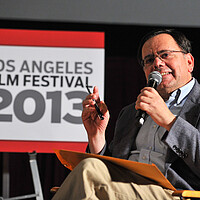Live, from New York, it’s the ‘SNL’ origin story ‘Saturday Night’
The entertainingly madcap “Saturday Night” takes place in the frenetic 90-minute run-up to the airing of the first “Saturday Night Live” show on Oct. 11, 1975. The events appear to be happening almost in real time, and in one continuous shot. The film’s director, Jason Reitman, maintains this deception by whizzing his camera in and out of dressing rooms, hallways, soundstages, the streets outside New York City’s 30 Rockefeller Plaza – just about everywhere.
All this vertiginousness isn’t exhausting because Reitman and his actors are always giving us something to look at and listen to. The freneticism isn’t a stylistic affectation. It’s central to the story. “Saturday Night” is about how creativity can sometimes issue from mayhem. It’s also about how sometimes mayhem is just mayhem.
In a few quick brushstrokes, we are introduced to the cast and crew. Lorne Michaels (Gabriel LaBelle), the creator and driving force of “SNL,” is a human tornado trying to wrangle a million movable parts and swelled heads. The nervous NBC honchos, notably Dave Tebet (Willem Dafoe), are ready to pull the plug right up until airtime and instead substitute a rerun of Johnny Carson’s “Tonight Show.” At least, Tebet figures, the rerun will draw a bigger audience.
When I first heard this film was in production, I assumed it wouldn’t work because audiences – or at least those old enough to remember – wouldn’t buy a cast of young actors impersonating the likes of John Belushi, Chevy Chase, and Gilda Radner. (They are played by, respectively, Matt Wood, Cory Michael Smith, and Ella Hunt.) But the performers for the most part deport themselves well. Along with Kim Matula (as Jane Curtin), Emily Fairn (Laraine Newman), and Lamorne Morris (Garrett Morris, no relation), they suggest the Not Ready for Prime Time Players without attempting to strictly mimic them.
Unfortunately, several of these players, notably Curtin, Newman, and, more surprisingly, Belushi and Radner, are given rather short shrift. The bulk of the film’s focus is on Michaels; his wife Rosie Shuster (Rachel Sennott), one of the show’s writers; and Chase, who comes across as the protagonist with the fattest ego – quite an achievement in this crowd. A backstage confrontation between Chase and a visiting Milton Berle (a great J.K. Simmons) encapsulates the movie’s central conflict of Old School vs. Young Turks. Berle is haughtily dismissive of these upstarts and predicts they will be forgotten. Chase represents the generation that grew up on television long after Uncle Miltie left the airwaves. What Berle and the NBC executives didn’t realize that fateful night is that “SNL” created a new audience along with a new show.
Like most actual “SNL” episodes, “Saturday Night” is a hit-and-miss affair, but somehow this seems appropriate to the subject. Some of the scenes, like the ones featuring the Muppets, are rather dim. Others, notably confrontations involving the viperish writer Michael O’Donoghue (Tommy Dewey), are spot on. The show’s uptight script supervisor – i.e., NBC censor – doesn’t stand a chance with him. (She’s well played by Catherine Curtin, no relation to Jane.)
Reitman and his co-writer Gil Kenan are not reaching for anything profound in this film, which is probably a good thing. But I wish they had made more of a point of what a boys club, specifically a white boys club, this show was. Except for Shuster, none of the women in the movie are really given much of a voice, even in dissent. Morris, the only Black member of the cast, wonders aloud about his tokenism. He deserved more screen time. The film also whitewashes the behind-the-scenes drug use.
Reitman may also be making too much of this moment in TV history. “SNL” didn’t represent a cultural revolution exactly. Loving the show did not preclude its newfound adherents from also cherishing reruns of “The Dick Van Dyke Show” and “I Love Lucy” and all the rest. “SNL” was more like a recalibration of what television could offer. And it made it up as it went along.
“Saturday Night” also seems made up on the run, except, of course, its improvisatory tone is an illusion. At its best, the film demonstrates a showbiz truism: It takes a lot of hard work to make something look easy.
Peter Rainer is the Monitor’s film critic. “Saturday Night” is rated R for language throughout, sexual references, some drug use, and brief graphic nudity.






